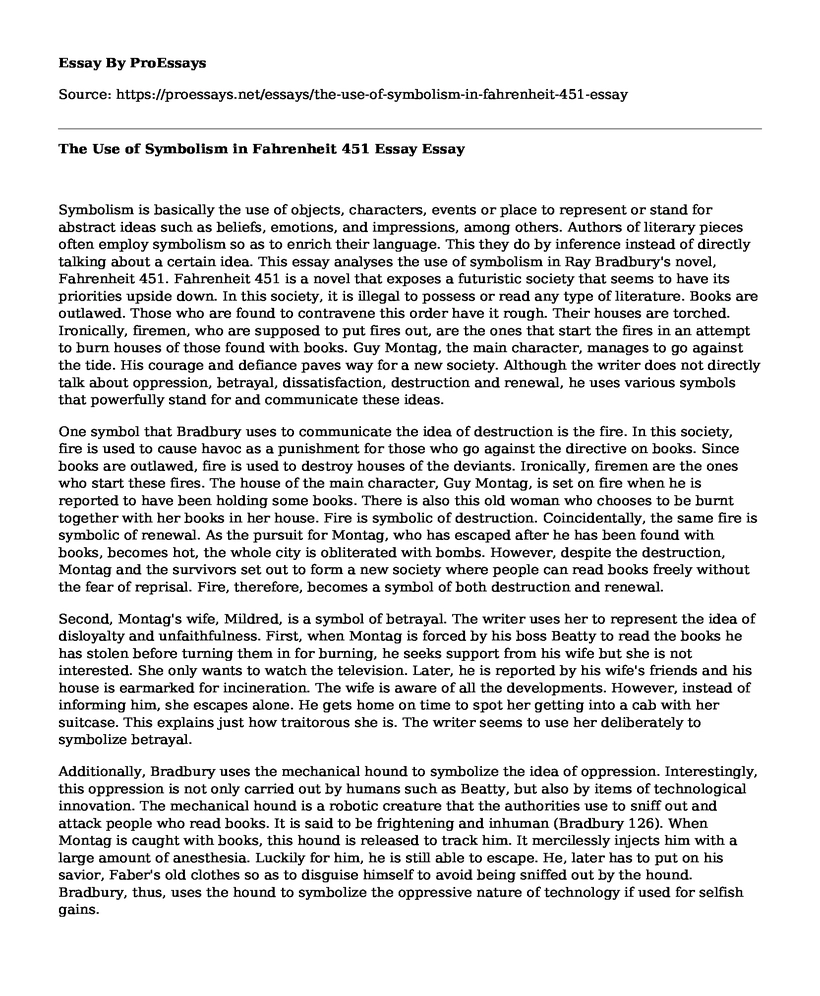Symbolism is basically the use of objects, characters, events or place to represent or stand for abstract ideas such as beliefs, emotions, and impressions, among others. Authors of literary pieces often employ symbolism so as to enrich their language. This they do by inference instead of directly talking about a certain idea. This essay analyses the use of symbolism in Ray Bradbury's novel, Fahrenheit 451. Fahrenheit 451 is a novel that exposes a futuristic society that seems to have its priorities upside down. In this society, it is illegal to possess or read any type of literature. Books are outlawed. Those who are found to contravene this order have it rough. Their houses are torched. Ironically, firemen, who are supposed to put fires out, are the ones that start the fires in an attempt to burn houses of those found with books. Guy Montag, the main character, manages to go against the tide. His courage and defiance paves way for a new society. Although the writer does not directly talk about oppression, betrayal, dissatisfaction, destruction and renewal, he uses various symbols that powerfully stand for and communicate these ideas.
One symbol that Bradbury uses to communicate the idea of destruction is the fire. In this society, fire is used to cause havoc as a punishment for those who go against the directive on books. Since books are outlawed, fire is used to destroy houses of the deviants. Ironically, firemen are the ones who start these fires. The house of the main character, Guy Montag, is set on fire when he is reported to have been holding some books. There is also this old woman who chooses to be burnt together with her books in her house. Fire is symbolic of destruction. Coincidentally, the same fire is symbolic of renewal. As the pursuit for Montag, who has escaped after he has been found with books, becomes hot, the whole city is obliterated with bombs. However, despite the destruction, Montag and the survivors set out to form a new society where people can read books freely without the fear of reprisal. Fire, therefore, becomes a symbol of both destruction and renewal.
Second, Montag's wife, Mildred, is a symbol of betrayal. The writer uses her to represent the idea of disloyalty and unfaithfulness. First, when Montag is forced by his boss Beatty to read the books he has stolen before turning them in for burning, he seeks support from his wife but she is not interested. She only wants to watch the television. Later, he is reported by his wife's friends and his house is earmarked for incineration. The wife is aware of all the developments. However, instead of informing him, she escapes alone. He gets home on time to spot her getting into a cab with her suitcase. This explains just how traitorous she is. The writer seems to use her deliberately to symbolize betrayal.
Additionally, Bradbury uses the mechanical hound to symbolize the idea of oppression. Interestingly, this oppression is not only carried out by humans such as Beatty, but also by items of technological innovation. The mechanical hound is a robotic creature that the authorities use to sniff out and attack people who read books. It is said to be frightening and inhuman (Bradbury 126). When Montag is caught with books, this hound is released to track him. It mercilessly injects him with a large amount of anesthesia. Luckily for him, he is still able to escape. He, later has to put on his savior, Faber's old clothes so as to disguise himself to avoid being sniffed out by the hound. Bradbury, thus, uses the hound to symbolize the oppressive nature of technology if used for selfish gains.
The other symbol used in the novel is the outlawing of books. This event is used by the writer to symbolize dissatisfaction. Although the authorities are dissatisfied with the idea of reading books, the people have this insatiable thirst for knowledge. It seems that this urge can only be satisfied by digging for more and more knowledge from books. Unfortunately, the authorities think that reading books will encourage conflicting views thus a disunited and unhappy society. This explains why they outlaw the culture. However, the more they discourage the reading of books, the more people take the risk. A good example is Montag, one of their workers, who steals books so as to try and discover what is hidden in them. The old woman, too, takes the risk and chooses to be burnt in her house. This shows the powerful symbolism brought by the illegal books.Conclusion
In conclusion, it is clear that Ray Cadbury chooses to communicate his message in a very unique way. Instead of using plain language to pass his ideas across, he uses symbols that perfectly represent these ideas. He uses the fire, Montag's wife, the mechanical hound and the outlawing of books to communicate ideas such as dissatisfaction, betrayal, oppression destruction and renewal. It is the power of these symbols that gives the text a literary taste since the reader has to apply critical reading skills to understand the main themes.
Reference
Bradbury, Ray. "Fahrenheit 451" Simon and Schuster Paperbacks, New York 2012.
Cite this page
The Use of Symbolism in Fahrenheit 451 Essay. (2022, Mar 09). Retrieved from https://proessays.net/essays/the-use-of-symbolism-in-fahrenheit-451-essay
If you are the original author of this essay and no longer wish to have it published on the ProEssays website, please click below to request its removal:
- Puritanism in Young Goodman Brown Essay
- Compare and Contrast Essay on Mora's poems: La Migra and Elena
- Specimens of Bushmen Folklore Paper Example
- This Is Nigeria by Falz Essay Example
- Essay Sample on Revenge Leads to Pain: A Study of Fictional Characters
- Essay Sample on Othello: Love, Hate, & Tragedy in Shakespeare's Classic Play
- Essay Example on The Art of Losing: Exploring Elizabeth Bishop's Poem One Art







